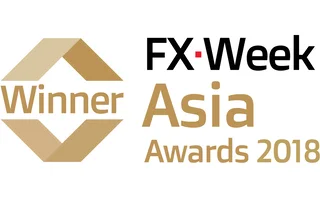
This article was paid for by a contributing third party.

Increased electronic execution in Asia-Pacific markets


Do clients based in Asia‑Pacific trade differently from those in other regions? No, says Anthony Hall, head of foreign exchange, rates and credit at UBS for the region. Clients globally are increasingly focused on complex algos, emerging markets and structured products where momentum is building for further electronification.
“We have planned enhancements in all of these areas over the next year,” says Hall. UBS was voted the winner in three categories at the inaugural FX Week Asia Awards, topping the Best FX Spot, Best e‑FX Trading House and Best FX Post-Trade Provider in Asia categories.
While electronification in spot contracts has almost reached saturation, non‑deliverable forwards (NDFs) and more complex products lagged behind. Hall notes that, over 2018, there has been a marked acceleration of electronic execution for NDFs and in emerging markets in general. “UBS continues to make significant investments in the development of our electronic NDF pricing and risk management capabilities to offer clients low latency, reliable and competitive pricing,” he adds.
The electronification of NDFs and derivatives has a strong tailwind coming from the Asia‑Pacific (APAC) region, where these contracts are most traded. Clients in the region are also driving demand for second-generation exotics and yield-enhancing structured products, which spurred UBS to invest in its FX options suite on single-dealer platform (SDP) Neo.
Hall says SDPs and multidealer platforms (MDPs) satisfy complementary needs for clients. For example, SDPs may offer additional functionality on top of execution that MDPs tend not to have available.
“We believe SDPs and MDPs complement each other in fulfilling the varying needs of clients,” notes Hall.
In the run-up to implementation of the revised Markets in Financial Instruments Directive (Mifid II) in Europe, dealers have questioned the prospects for SDPs as best execution requirements seemed to threaten the viability of such single-liquidity platforms. But, as the January 2018 deadline approached, attitudes towards SDPs reversed and market participants’ activity increased on these platforms rather than decreased.
Neo provides clients with access to a range of features and functionalities across products including FX, rates and credit, and equities and research. The system offers open but controlled access and a transparent environment for collaboration, pre-trade analysis, execution and post-trade management. “Fulfilling these broad expectations would not necessarily be feasible through the MDPs. Simultaneously, we continue to work closely with our MDP partners with the aim of providing liquidity to clients agnostically through venues most relevant to them,” Hall adds.
The ability to choose a platform on which to access liquidity is critical for clients, especially if they trade in emerging market currencies, some of which have seen significant volatility during 2018.
“FX spot market volumes are up year-on-year in 2018, driven by a strong first quarter. While liquidity in the Group of 7 economies remains high, emerging market currencies – such as the Turkish lira and the South African rand – can be challenging,” says Hall.
General investor nervousness about emerging markets has been an additional factor in slightly lower levels of activity in FX options, however, as implied volatilities have been on a downtrend for more than three years, bar occasional idiosyncratic episodes such as Brexit.
“Overall, we have seen more FX Spot activity from clients across segments and regions. In swaps, liquidity remains high, leading to increased competition for flows and spread compression,” adds Hall.
In APAC, Mifid II has had a limited impact on the way clients execute, but for some marginal changes. One area where the impact of the European regulation has been most readily felt is the level of transparency available to clients.
Enhanced transparency around electronic trading practices, costs charged by dealers and the behaviour of liquidity providers has led to more information available to FX market participants, but the wave also brought with it additional operational complexity such as the need to understand International Securities Identification Numbers and other relevant new requirements when trading with European counterparts.
On top of additional operational hurdles, clients adapted to decreasing risk-warehousing periods by dealers with the use of algorithms. And, while execution algos are increasingly well-used in G10 currencies and spot markets, Hall sees growing interest for deploying these tools in emerging markets as well.
“Our focus will be driven by client demand in areas such as complex algorithms, emerging markets, and structured products,” he says.
“The emphasis on best execution, liquidity management and analytics has prompted clients to look towards execution via algos. We will continue to refine our suite of algo strategies to match
the ever-changing and increasingly sophisticated needs of our clients,” Hall concludes.
Sponsored content
Copyright Infopro Digital Limited. All rights reserved.
You may share this content using our article tools. Printing this content is for the sole use of the Authorised User (named subscriber), as outlined in our terms and conditions - https://www.infopro-insight.com/terms-conditions/insight-subscriptions/
If you would like to purchase additional rights please email info@fx-markets.com
Copyright Infopro Digital Limited. All rights reserved.
You may share this content using our article tools. Copying this content is for the sole use of the Authorised User (named subscriber), as outlined in our terms and conditions - https://www.infopro-insight.com/terms-conditions/insight-subscriptions/
If you would like to purchase additional rights please email info@fx-markets.com